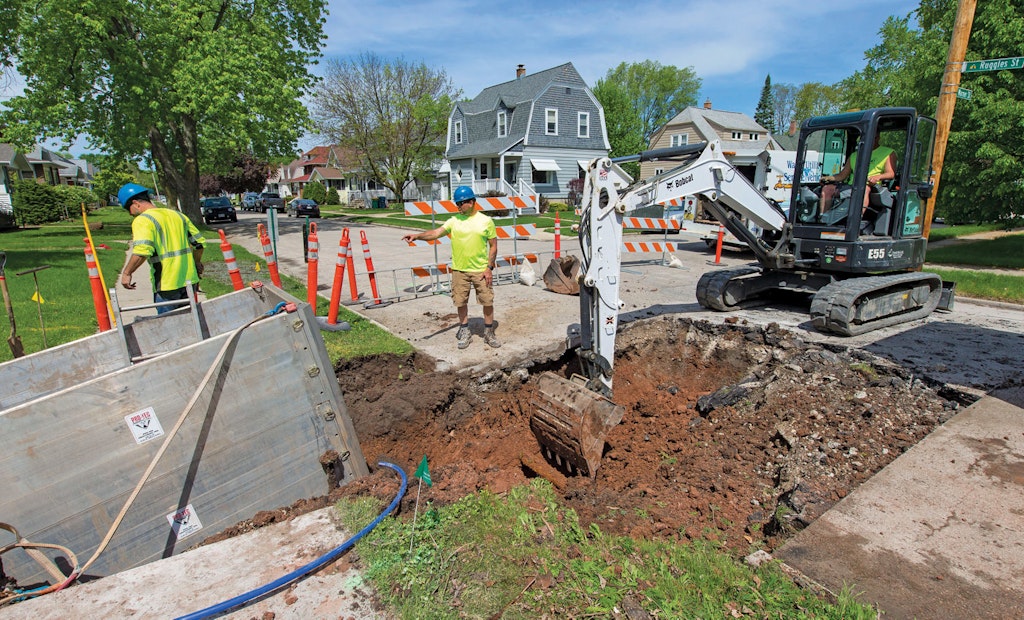
Fond du Lac Water Utility water distribution maintenance crew members Rob Scheeler (left) and Kevin Speerf work on replacing a lead water service line with new poly pipe at a residential location.(Photography by Mike Roemer)
Technology can be daunting, but the city of Fond du Lac, Wisconsin, is learning to let it work for them, simplifying day-to-day management of their water utility.
The city’s water utility has been around since 1885, and much of the original system is still in service today. But the Fond du Lac Water Utility is striding toward the future with major initiatives like a proactive lead replacement program, GIS mapping and implementing automated systems.
A complex system
In recent years, the city has experienced its fair share of leaks and main breaks: an average of about 70 breaks per year for the last five. They haven’t measured nonrevenue water lost through leaks, but it’s on their list.
“Maintaining the infrastructure is always a challenge,” says Travis Kloetzke, water utility general manager. “Keeping everything operational and functioning properly is a challenge.”
The system, which serves around 16,000 customers, consists of 224 miles of pipe, with 3,000 valves and almost 1,800 fire hydrants. Four treatment plants capable of producing 15 mgd distribute an average of 4.5 mgd over a 20-square-mile service area.
“One of our biggest challenges is just aging infrastructure as a whole. We do have mains that date back to the 1800s, although it seems not necessarily the oldest mains cause the most problems,” Kloetzke says.
Throughout its history, Fond du Lac has tried nearly every type of common pipe material — from lead to copper, then cast iron, ductile iron, polywrapped ductile iron, and finally polyvinyl chloride.
The combination of a fluctuating climate with acidic clay soils made problems for all but a few kinds of pipe. The acidic soils are corrosive, causing pinhole leaks in copper and degrading joints in ductile iron; extreme weather causes a lot of ground movement — frost heave in winter, and shrinking clay in summer heat — which means cracking in cast iron mains. Copper and iron pipes with projected life spans of 70 to 80 years are having problems after 50 to 60. Today they use all PVC.
Even though many of the oldest pipes are in great shape, they are also made of lead. From approximately 1885 to about 1920, the city was exclusively installing lead pipes.
Get the lead out
One proactive effort the city has undertaken is a public outreach campaign called “Get the Lead Out.”
“The goal there is to remove all the lead services within the city,” Kloetzke says.
Fond du Lac has not experienced any lead issues so far, but with the current national attitude, it has become a priority.
“I think the catalyst for the lead talk in general has really been Flint, Michigan. It seems like since that unfolded, the talk of lead has been more and more, and I don’t think it’s going to go away,” Kloetzke says. “We do sample lead annually — we do two sets of 60 samples every year. Historically we have not exceeded the level set by Wisconsin Department of Natural Resources, so currently we have not had any lead issues; this is a proactive effort.”
The program, encompassing 4,500 lead services in the city, began in 2017. Lead service replacement had taken place before that on the public side, but with funds from the Safe Drinking Water Loan Program, they have expanded the program to include private-side services.
With the grant, they were able to offer up to $2,000 or 50 percent of the private-side repair through 2017. Around 25 to 30 customers took advantage of the subsidy, and Kloetzke says the list of volunteers is already a lot higher than that for 2018, thanks in part to increasing the subsidy to $3,000.
The average cost of a private-side lead pipe replacement was $3,300 in 2017.
“We want to stretch that money out. It’s good for three years, and we want to keep that going and be able to supply it and provide it to those property owners for the next three years here.”
The state Legislature recently passed a bill that allows the city to subsidize projects like this with loans and grants from ratepayer dollars, so Kloetzke says the city is hoping to continue funding the project even after their loan money runs out.
For the time being, lead service replacements are only taking place during emergency repairs and larger annual construction projects. Services are not actively slated for replacement at this time.
“A lot of people don’t even understand that they have a lead service. They just know that they turn the water on in the kitchen and it comes out. So that’s kind of where the problem lies — to educate the public and try to get them to invest money into their own water service to remove the lead,” Kloetzke says.
Map for the future
Another ambitious project that’s been in the works for seven years is finally reaching fruition.
Using ArcGIS from Esri, Fond du Lac built a GIS map of its entire system using old historical records.
“We didn’t really have good computer records of all the water mains,” says Chad Churchill, the water utility engineer who spearheaded the GIS project. “We had really good attribute data: historic numbers and quantities that would get carried over year to year, just in a file cabinet, paper copies, but we really didn’t have a visualization of all the data. So we worked to recreate all that data by digitizing and interpreting historic construction plans.”
Though it was a long process, the new GIS map has come in handy on many projects, especially in locating shut-off valves quickly on water main breaks. The maps are accessible on field workers’ smartphones and tablets.
“We’ve been utilizing that technology pretty heavily in the last two years, and I would imagine in the future here we’re going to keep using it, as we keep coming up with better ideas on how to utilize it,” Kloetzke says.
The biggest benefit so far has been using the GIS to dictate replacement schedules for problem pipes. By inputting data on past main breaks, they’ve been able to pinpoint the system’s weak points.
“Up until now, our whole main replacement has been based on age. Basically we target the oldest main first, and that’s misleading because it’s not necessarily the oldest main causing you the most problems,” Kloetzke says. “With that GIS data, we’ll be able to analyze that and allocate our maintenance money where it’s going to give us the biggest bang for our buck.”
They are also looking to the future with automated technology.
Already they’ve installed advanced metering infrastructure from Badger Meter, providing instantaneous water consumption reports from all the system’s customers. Utility officials hope to integrate their AMI, SCADA and GIS systems to become a comprehensive next-generation water utility.
“Taking all three of those and putting them together, you can almost have a live water-loss report: This is what we’re pumping and treating, but this is what we’re actually selling,” Kloetzke says. “Having the meters in there also gives us access to the customer information, to potentially have that automatic notification go out stating that there’s a main break in your area and your service could be disrupted.”
Worth the effort
It’s easy to look ahead at the challenges of implementing new technologies and hesitate, but in the end, the results speak for themselves.
“There’s quite a lot of efficiencies with technology,” Churchill says. “Obviously technology continues to improve from year to year, and there are new ways to gather data, so we’ve implemented a lot of new applications, new tools. It has really increased the efficiency and the usefulness of that data; that then drives future maintenance cycles.
“It frees up time that used to be spent on maintaining these models; now we can do analysis on the models. We’re gathering that data, and then we’re bringing it back to this model so that we have a more complete picture of our system. As the old adage goes, ‘A picture is worth a thousand words.’”








